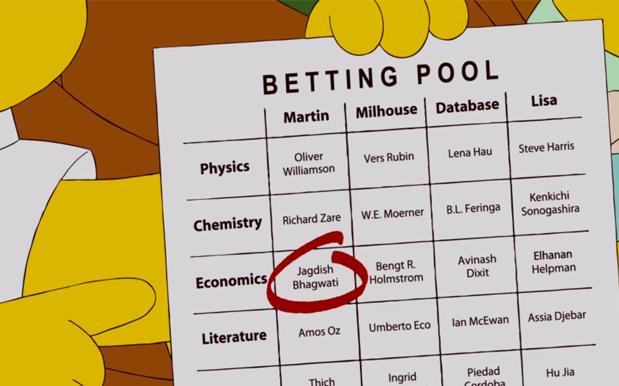
Superfans and awesome nerds among you will already know this, but for those who don’t: ‘The Simpsons‘ is actually way, way, way, WAY more mathematically-focused than you might think.
The show, historically, has been written by pure maths-nerds, and is littered with a shitload of hidden mathematical, theoretical, and numerical references throughout its history. ‘Treehouse of Horror VI,’ for example, shoves five minutes of arguably the most intense pure maths ever broadcast to a mainstream audience right under the noses of unsuspecting viewers. Among other things, the episode features an equation that either breaks, or comes dick-achingly close to breaking, the infamous Fermat’s last theorem. Which is precisely the kind of thing you’d tuck away in background-art when your show is running at God-like levels.
Those who have served as writers and produces have included pure maths grads, some with PhDs, and even one (Al Jean) who went to Harvard to study maths at just 16 years old. The point being, the show has always – ALWAYS – known its stuff.
So if any series in the history of television as a medium was going to accurately pick a Nobel Prize winner in the field of Economics six-years in advance, it’s ‘The Simpsons.’
Back in 2010, ‘The Simpsons‘ aired its 22nd season premiere ‘Elementary School Musical‘ (a widescreen episode, so we’re not shocked if you haven’t seen it). The episode opens with Lisa, Milhouse, Martin, and Database watching the Nobel Prize announcements, which included a brief shot of a sweeps card the kids had running.
Milhouse, as the time, had MIT Professor Bengt R. Holmström for the Economics gong.
As it turns out, he was six years ahead of his time, because earlier this morning Professor Holmström did indeed get the nod for his continued contributions to contract theory.
Fun fact: @TheSimpsons‘ Milhouse once predicted MIT Prof. Holmström would win a #NobelPrize. Today, he was right! https://t.co/CC0LRk1avy pic.twitter.com/syhMiJBK2A
— MIT (@MIT) October 10, 2016
For what it’s worth, since the episode aired in September of 2010, that card has yielded two more accurate Nobel Prize predictions.
Database nailed his pick for Chemistry in B.L. Feringa, a Dutch synthetic organic chemist who picked up the laureate this year for “the design and synthesis of molecular machines.” Meanwhile Milhouse was on the money with his chemistry pick, William E. Moerner, the recipient of the 2014 laureate for “the development of super-resolved fluorescence microscopy.“
That’s two points on the board for Milhouse.
The Van Houten kid might be a bit of a Poindexter, but he’d be making a killing betting on the Nobel Prize markets.
Source: MIT/Twitter.







